BY LETTER
Superterrestrial Worlds
Superterran planets | |
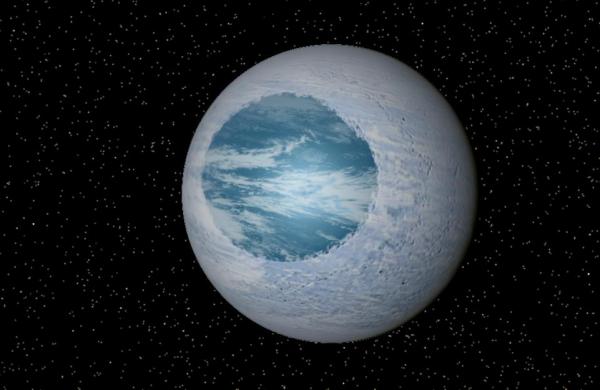 Image from Steve Bowers | |
| Yanqiu, a Polyphemian subtype superterrestrial (a so-called 'eyeball superearth'). The warmest point on the surface of an icy, tidally locked world of this kind is more-or-less directly below the local sun at the sub-solar point. On Polyphemian worlds the ice in this region has melted, creating a patch of open ocean which might sustain life | |
Giant terrestrial worlds: 2.5 to 10 Earth Masses
This common and familiar planetary type was at one time completely unknown to Terran science, since no examples exist in the Old Solar System. Before long-range probes first arrived in systems containing such planets, the properties of such worlds were largely hypothetical. In the current era superterrestrial worlds have been extensively studied and classified into a number of categories; some such categories resemble those which define the different types and subtypes of terrestrial world, while others are quite different. There are many transitional and hybrid types as well, which cannot be easily classified into a single category.Like terrestrial world types, many superterrestrial world types are defined by their composition, in particular the fraction of core, mantle, ices (especially water ice) and the density and composition of the atmosphere. Other characteristics such as temperature, rotation (from rapid rotators to tidally locked worlds), tilt and eccentricity are also important.
SuperHermians | |
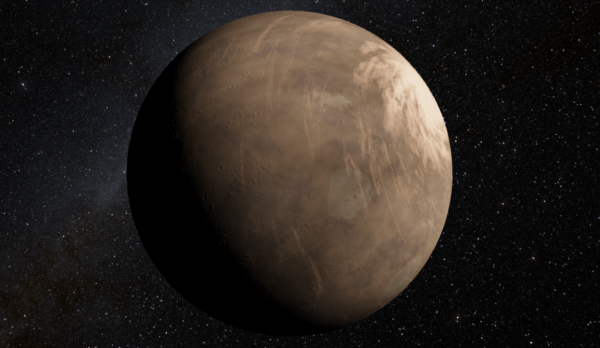 Image from Steve Bowers | |
| Trebah, a very large tidally-locked SuperHermian world, with a thin atmosphere. | |
SuperHermian Type (SuperMercuries)
Dry, rocky, dense worlds with unusually thin atmospheres.
These worlds are quite rare, because their dense nature mean they have quite high surface gravities. SuperHermian worlds with a mass 2.5 x Earth and a core that makes up half its mass have a diameter of around 15 960 km and a surface gravity of 1.6 gees. This means that even the smallest superhermians have a high gravity, and are more likely to retain gases than smaller or less dense worlds. Superterrestrials which have minimal atmospheres only form in locations where volatiles are rare, or sometimes they form with larger atmospheres then lose them in cataclysmic events of various sorts.
The most massive, dry, airless worlds are very rare, and have very high surface gravities for planetary objects. One of the largest, Trebah, in the Andromeda Prefecture of the Solar Dominion, has a mass 9.8 x Earth, a diameter of 21920 km and a surface gravity of 3.34 gees. This world formed from the collision of two somewhat smaller dry worlds shortly before the local star ignited; when the light of the new sun burst upon these two worlds they were still coalescing, and they lost most of their remaining volatiles in this event.
Chthonian Superterrestrials | |
 Image from Steve Bowers | |
| Sisyphos, a cthonian superterrestrial in Hydra | |
Chthonian Superterrestrials
Another type of superterrestrial with a depleted atmosphere is the Chthonian type, worlds which have lost their atmospheres gradually, rather than during formation or in a cataclysm. These were formed with normal amounts of volatiles but have migrated so close to their star that they have lost almost all of it over time. Some are as dry and denuded as any superhermian world, and have a remnant atmosphere often containing metal or silicate vapours of various kinds. Others have thicker atmospheres with nitrogen and carbon dioxide predominating, most hydrogen and helium having evaporated.Pyrothallassic worlds | |
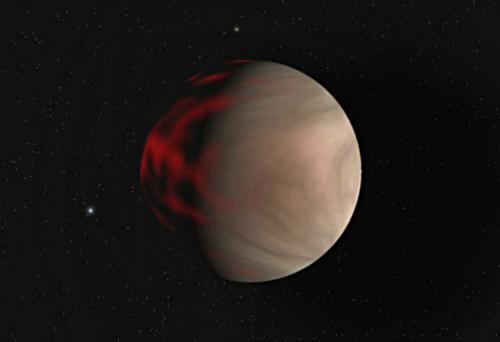 Image from Steve Bowers | |
| Janssen, a hot carbon-rich superterrestrial in the 55 Cancri system, with an atmosphere containing significant amounts of hydrogen cyanide | |
Some worlds with hot thick atmospheres are hot enough that the crust becomes partially or completely molten. Not all pyrothallassic worlds are dry; some have deep, hot water oceans beneath a dense wet atmosphere. A supercritical layer, neither liquid or gaseous, is often present. Hot waterworlds of these kind (known as pyrohydrothalassic worlds in the NoLWoCS classification scheme) are more common around cooler stars with lower UV emissions.
SuperCytherian worlds (SuperVenuses)
Hot, dry planets with thick carbon dioxide atmospheres. These worlds are often formed with a moderate water content in the crust and atmosphere, but are heated by a combination of insolation and greenhouse effect so that the water is dissociated and the hydrogen is lost. The remaining oxygen combines with carbon in the crust to form the typical thick cytherian CO2 atmosphere, which usually has nitrogen as a major component, and may contain argon, helium and neon as well as more exotic trace gases. Beneath the thick atmosphere these planets are comparable in density to superhermian worlds, and have surface gravities ranging from 1.5 to 3.6 gees, but the atmospheric pressure at the surface is generally very high indeed, and so is the surface temperature.Supercytherian worlds are generally formed close to their star, but sometimes are formed further out and migrate inwards after formation. Some become hot and dry briefly when the local star leaves the main sequence and becomes a subgiant or giant star.
SuperGaians (SuperEarths) | |
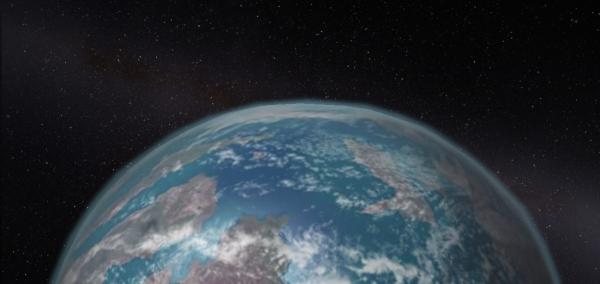 Image from Steve Bowers | |
| Abbas, a lifeless supergaian terraformed and inhabited by clades tolerant of high gravity | |
SuperGaian worlds (SuperEarths)
Superterrestrials with a partial hydrosphere (between 1% and 100% coverage) and superficial rather than deep oceans. These worlds have some resemblance to terrestrial gaian worlds, but are larger and denser and have stronger gravity. As with the supercytherian worlds these planets have surface gravities in the 1.5 to 3.6 gee range. For this reason the atmospheres of supergaian worlds are generally, but not always more dense than their terrestrial equivalent. Lifeless supergaians generally have atmospheres with a significant nitrogen fraction, and carbon dioxide is often present. Argon and/or neon may also be present; helium is often retained by the more massive or cooler supergaians.For a particular atmospheric pressure, the higher gravity causes the atmosphere to be more compact; equivalent cloud-layers are lower, the troposphere and other layers are less high and rainfall is heavier on impact. Erosion on such worlds is strong, and hills and mountains are generally lower and more quickly eroded away. Where the atmosphere is denser wind erosion is also significant. Plate tectonics is almost always significant on supergaians, because of the effect of water content on friction in the relatively thin crust of such worlds.
Superterrestrials with indigenous life | |
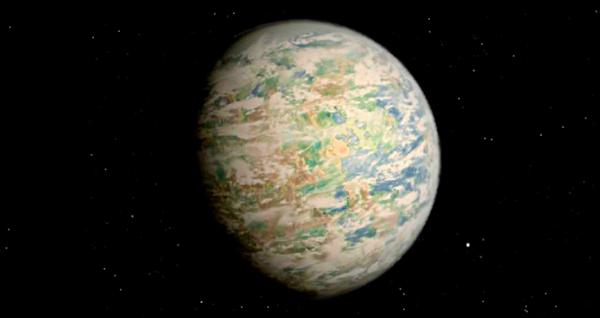 Image from Steve Bowers | |
| ,Simurgh, a superterrestrial garden world | |
A fraction of supergaians support indigenous biospheres, and are therefore classified as garden worlds. A very few support complex biospheres, with robust mobile organisms of various kinds, most of which have many legs to support their greater weight. There are some indications that the unnamed, extinct species HIE636MZE may have evolved on a supergaian type world, but this has not been confirmed. Examples of superterrestrial garden worlds include Seattle and Simurgh.
With respect to carbon dioxide content there is a continuous scale between supergaian and supercytherian worlds; the cut-off point is set at 10 bars of partial pressure of CO2. Wet, hot greenhouse superterrestrials with superficial water cover are known as the SuperTo'ul'hian subtype, by analogy with their smaller terrestrial equivalents. Supergaians with respectably large carbon dioxide fractions are quite good candidates for terraforming, but although the resulting world has sufficient oxygen to support life it does not closely resemble the environment on Old Earth.
SuperAreans
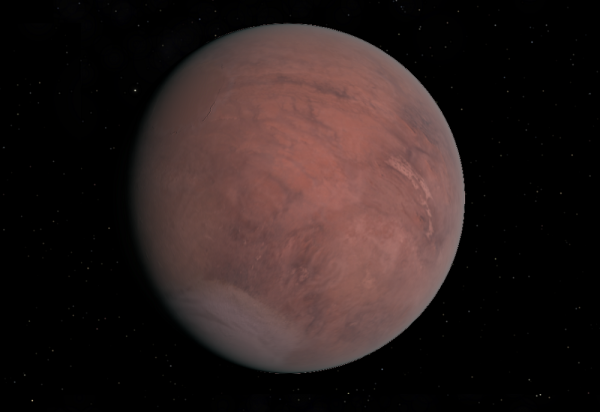 Image from Steve Bowers |
Superterrestrials with more exotic compositions
Planets with thick atmospheres containing substantial amounts of greenhouse gases can maintain a layer of liquid at a further distance from the local star. Ammonia is a greenhouse gas, and the presence of this gas in a superterrestrial atmosphere can warm a cooler world enough to permit the formation of ammonia/water seas and oceans. These are known as SuperAmaunetian worlds in the NoLWoCS classification scheme; a small fraction support biospheres.Carbon-rich superAdamean worlds are not uncommon, and generally have very thick carbon-dioxide or carbon-monoxide atmospheres depending on the local abundance of oxygen. Such worlds often have many organic compounds in the atmosphere, on and beneath the surface. The inner mantle of carbon superterrestrials may consist of highly-compressed diamond, which conducts heat readily. For this reason these planets have often cooled rapidly and lost their internal heat, leading to a locked core and negligible magnetic field. Even though these worlds have relatively high escape velocities, the lack of a magnetic field can lead to hydrogen depletion.
Oxygen-poor worlds in the cooler reaches of a planetary system low in UV may have liquid ammonia seas and oceans. These are the SuperAmunian type world, some of which support biospheres which are quite unlike those found on Earth-like planets.
SuperVitriolic worlds with sulphuric acid biospheres, and SuperHalogenic worlds with chlorine biospheres, are almost vanishingly rare, but are found on occasion; these are believed to be the relics of ancient experiments by long-vanished xenosophonts, and only a few dozen are known.
Superterrestrials which have retained a large helium atmosphere are known as Helian worlds; these may have supergaian or supercytherian characteristics, or have more exotic components in their atmospheres.
Pyrohydrothalassic Worlds and Panthallassic worlds | |
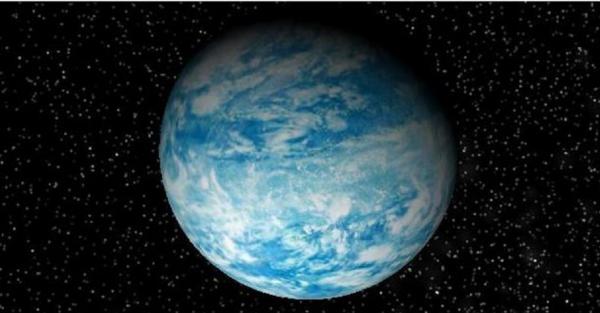 Image from Steve Bowers | |
| Giant waterworlds such as Panthallassa | |
Known as waterworlds, these planets have deep hydrospheres which often have a layer or mantle of high-pressure ice beneath the liquid layer. These worlds have large amounts of water vapour in their atmospheres which can be split by sunlight into hydrogen and oxygen; on panthallassic worlds the hydrogen can escape and leave behind an oxygen-rich atmosphere. Indigenous life on these worlds is rare, as abiogenesis rarely happens in such dilute environments.
Larger ocean worlds, known as pyrohydrothalassic worlds, are massive enough to retain hydrogen, and this gas reacts with any free oxygen to form water and water-vapour. resulting in a thick anoxic atmosphere. Other water-rich superterrestrials include super-bathypelagic worlds and colder, ammonia-rich superamaunetian worlds.
Icy Superterrestrials
These orbit outside the snow line, where the light from the local star is weak and water ice inparticular remains solid. Because they are less dense than the rocky worlds described so far, these worlds have lower surface gravities, and larger radii for any given mass. An icy super terrestrial of 2.5 x Earth's mass with 50% ice content (the rest being half mantle and half core) will have a diameter of around 20400 km, and a surface gravity of 0.9 gees. Examples with 10 x Earth's mass and similar characteristics have a diameter of 26800 km and a gravity of 2.2 gees. This is enough gravity to hold on to hydrogen at those cooler temperatures, so many icy superterrestrials have thick or very thick atmospheres. These worlds are classified as SuperTitanian type worlds, and their atmospheres can be very dense, so that visually they may resemble small gas giants.However supertitanian type worlds are distinguished from small cryojovians and gas dwarfs by a larger ice and rock fraction and a greater density.
Some icy superterrestrials have depleted atmospheres, sometimes caused by cataclysmic events in the planet's past or during formation. These fall into two main types; SuperYmirians which have solid ice layers above the rocky mantle and core, and SuperEuropans which have a liquid layer of water, a subsurface ocean, caused by internal heating (from residual heat, radioactive heating and/or tidal heating). A distinctive subtype of supereuropan world is the Polyphemian subtype, the so-called 'eyeball worlds'; tidally locked icy worlds with a liquid ocean around the subsolar point. SuperPolyphemians may have very large liquid oceans and oxygen rich abiogenic atmospheres, so are reasonably easy targets for colonisation for mildly tweaked clades.
Gas Dwarfs | |
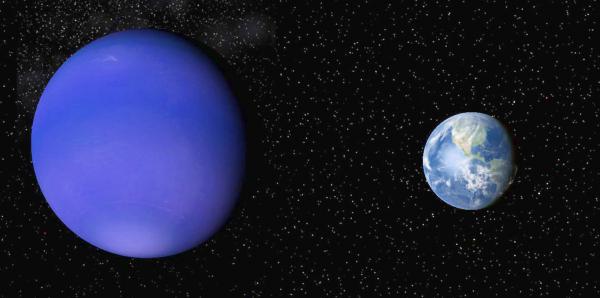 Image from Steve Bowers | |
| The warm gas dwarf Kepler 11f compared in size to Earth | |
Gas Dwarfs
Superterrestrials with very large atmospheres and small, low density cores (consisting mostly of ices in most examples) are known as gas dwarfs. These have very low gravity for such large objects and all but the coldest examples are constantly losing gases to outer space. For that reason they are more common in young systems. Over time these worlds will lose hydrogen and helium preferentially, leaving behind heavier gases such as nitrogen, neon and argon. Some have gaseous compounds such as carbon dioxide, ammonia, nitrous compounds and water vapour as major components of their atmospheres. The warmest examples, usually tidally-locked vesperian types, have silicates and metallic clouds swirling from the sunlit hemisphere to the cooler hemisphere.Other Characteristics
As mentioned earlier, all these world types may be further modified by orbital or rotational characteristics; tilted worlds have characteristics of the Skolian subtype, eccentric worlds have Ikarian characteristics, fast-rotating planets have Aeolian characteristics, the very common tidally locked worlds have Vesperian characteristics, and so on. Some superterrestrials exist as binary (Dioscuran) pairs, and fill their Roche nodes to a varying extent. Some superterrestrials have ring systems, usually found around the largest worlds which retain these features for a longer period.The very hottest gas dwarfs and helian worlds are swollen by expansion to a considerable extent, and may have visible tails like giant comets. On the other hand, many superterrestrials have been ejected from their planetary system altogether, and are found wandering in deep space as stevensonian class superterrestrials, with frozen atmospheres but sometimes warmed by considerable internal heat flows.
Related Articles
Appears in Topics
Development Notes
Text by Steve Bowers
Initially published on 15 December 2011.
Initially published on 15 December 2011.






